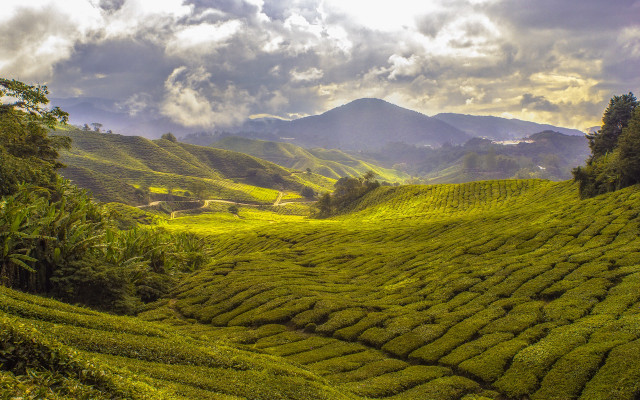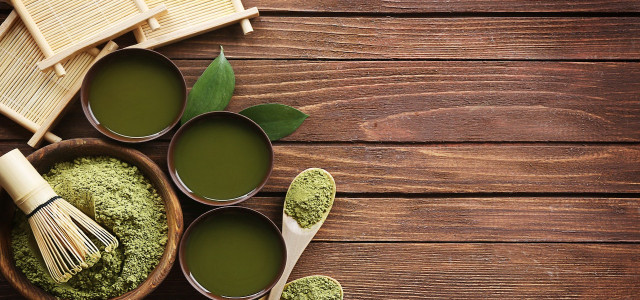Despite the fact that both beverages are derived from the same plant, they couldn’t be more different. We’ll take a look at matcha vs. green tea to see how they differ, and the benefits of drinking them.
Matcha and green tea are both made from the leaves of the Camellia sinensis plant, but the similarities end there. Green tea is sold in either loose leaf or bagged form, while matcha is a fine powder. Each beverage has its own benefits for the body, unique flavor profile and ways to prepare it. We’ll compare matcha vs. green tea so you can decide for yourself which is best.
What is Matcha?
If you walk into any speciality coffee or tea shop, you’ll probably find some sort of matcha beverage on the menu. If you’re wondering what it is, matcha is a type of green tea made by grinding up specially grown young tea leaves into a bright green powder. Due to the use of the whole leaf and higher concentrations of chlorophyll, matcha has a very grassy and earthy flavor. For many, it’s an acquired taste, and flavored matcha lattes have been created to help tone down the unique taste.
What is Green Tea?
Green tea is made from unoxidized leaves and is one of the least processed types of teas, meaning it’s full of antioxidants and polyphenols. Green tea has a very subtle flavor, and can be combined with herbs and fruit for a more enjoyable beverage. Like other teas, it is a watery beverage with a delicate taste and fragrance, though you can create a more intense flavor by allowing the leaves to steep longer in the pot.
Tea Cultivation

For those who don’t know, matcha, black tea, green tea, yellow tea, white tea, and oolong tea all come from the same plant. Crazy, right? How and where each plant is grown and harvested is what creates the difference in both flavor and nutritional benefit.
Green Tea Cultivation
- Cultivation of green tea mostly takes place in China and the plants are grown in the sun right up until harvest.
- Once plucked, the leaves are often steamed, baked, or pan-fried immediately after picking to stop the oxidation of the leaves so they retain their leafy green color.
- Afterwards, the leaves are rolled to help break down the leaf cell structure, which consequently releases the oils from the leaves which cause the unique flavor.
- Then the leaves are dried or fried in an oven to ensure no more oxidation occurs and locks in the final flavor.
Matcha Tea Cultivation
- The majority of the world’s matcha cultivation takes place in Japan.
- During the last 2-3 weeks before harvest, the plants are covered so they are grown in the shade. The lack of sunlight triggers the plants to produce more chlorophyll and results in higher concentrations of the therapeutic compounds matcha tea is known for.
- After the leaves are harvested, they are steamed and stone-ground into a fine powder.
Matcha vs. Green Tea Preparation Methods



Preparing tea isn’t as simple as adding a tea bag to some hot water — though it’s not much more complicated than that. Generally speaking, each type of tea has a recommended water temperature and steep time.
Green tea is brewed the same way any other tea is: the optimal temperature is between 150 – 180 degrees Fahrenheit, and recommended steep time is between 3-5 minutes, depending on your preference.
Matcha tea, however, is prepared more like a hot chocolate powder; it has to be mixed into the water and whisked until it has a frothy consistency. Traditionally, a bamboo whisk (called a chasen) is used to combine the powder into the water. Matcha tends to clump very easily, and whisking the powder into the liquid enables a smoother consistency. It’s also important to note that you should never use boiling water to prepare matcha tea, as it can negatively affect the flavor.
Benefits and Drawbacks: Matcha vs. Green Tea
Green tea has long been thought to be one of the healthiest beverages on the planet because it’s packed with antioxidants. It also contains a catechin known as ECGC, which may help reduce inflammation, aid in weight loss and prevent certain chronic diseases. Additionally, green tea contains an amino acid called L-theanine, which helps to regulate blood sugar levels and, due to its caffeine content, green tea may also help improve brain function.
All of the health benefits of green tea are essentially multiplied when drinking matcha. This is because you are consuming the whole leaf, meaning you’re ingesting all the nutrients associated with the green tea plant. Green tea, on the other hand, is just water steeped with the leaves, so while you may get some of the benefits, you end up throwing out the part that holds the most nutrients.
However, while the beverage may have a host of benefits, there are also some side effects to be aware of. For some people, consuming both green tea and matcha may result in stomach problems, headaches, iron deficiency, trouble sleeping, dizziness, irregular heartbeat and low blood pressure. If you are pregnant or breastfeeding, green tea should only be consumed in small amounts – less than 2 cups a day.
Conclusion
The health benefits of green tea can be enjoyed whether you choose to drink green tea or matcha. Due to their unique flavor profiles, you simply need to choose whichever one tastes best to you. For example, if you need to add sweetener or milk to your matcha to make it palatable, perhaps green tea is the healthier choice for you.
Seeing as the majority of Camellia sinensis plants are grown in Asia, green tea and matcha powder have a long way to travel before they reach our stores. Both beverages have a large range of health benefits, however they may not be the most sustainable choice. Consider drinking herbal teas, which have their own health benefits and can be made from herbs (like sage) from your own herb garden. Herbal teas also make great remedies for coughs and colds, as well as helping with stress and anxiety.
It’s also worth noting to enjoy any type of tea beverage in moderation. After all, it is possible to have too much of a good thing!
Important Information regarding Health-related Topics.
** Links to retailers marked with ** or underlined orange are partially partner links: If you buy here, you actively support Utopia.org, because we will receive a small part of the sales proceeds. More info.Do you like this post?








